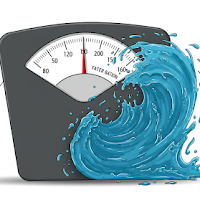You ate clean all week, but the scale went up. Here’s the science of why that number isn’t the whole truth.
It's the most frustrating moment of any health journey. You’ve been disciplined, you’ve done everything right, and you step on the scale expecting a reward—only to see the number is the same, or even higher, than it was yesterday. It feels like a betrayal. Is your body broken? Was all that hard work for nothing?
The answer is no. Your body is not broken, and the scale isn't exactly "lying"—it's just telling you a very incomplete story. The number you see reflects your total body mass, and the most volatile, wildly fluctuating part of that mass is water.
Deconstructing the Scale
The number on the scale is the sum of many parts. Fat is only one of them.
While your fat mass changes slowly and steadily, your water weight can change dramatically—by up to 5 pounds or more—in a single 24-hour period. Understanding what causes these swings is the key to freeing yourself from the tyranny of the scale.
The 4 Main Culprits of Water Weight
1. Sodium
How it Works: Your body likes to maintain a precise balance of water and sodium. When you eat a high-sodium meal (like pizza or takeout), your body holds onto extra water to dilute the sodium and restore that balance.
On the Scale: A single salty meal can cause a temporary gain of 2-4 pounds.
2. Carbohydrates
How it Works: When you eat carbohydrates, your body stores them as glycogen in your muscles and liver for energy. For every gram of glycogen stored, your body also stores about 3-4 grams of water along with it.
On the Scale: A higher-carb day can easily cause a 3-5 pound "gain." This is also why low-carb diets cause rapid initial "weight" loss—it's mostly water.
3. Exercise
How it Works: A tough workout, especially strength training, creates micro-tears in your muscle fibers. Your body responds by sending water to those muscles to help repair them. This inflammation is a normal and necessary part of getting stronger.
On the Scale: It's common to see a 1-3 pound increase for a day or two after a hard workout.
4. Hormones
How it Works: For women, the menstrual cycle has a huge impact on fluid retention. It's extremely common to see the scale tick up in the days leading up to a period due to hormonal shifts.
On the Scale: A monthly fluctuation of 2-5 pounds is completely normal.
The Real Picture: Fat Loss vs. Weight Fluctuations
This is the most important concept to grasp. True fat loss is a slow, steady, downward trend that happens over weeks and months. Daily weight is a noisy, chaotic data point that bounces up and down. If you only focus on the daily number, you'll drive yourself crazy. You need to zoom out and look for the trend.
Your Progress is a Trend, Not a Single Dot

Your Smarter Progress Tracking Toolkit
The scale is just one tool—and not a very good one. To get the real picture of your progress, use a combination of these superior methods.
-
Take Progress Photos: Once a month, take photos in the same outfit and lighting. The visual changes are often more dramatic than what the scale shows.
-
Use a Tape Measure: Track your waist, hip, and thigh measurements. Losing inches while your weight stays the same is a clear sign you're losing fat and gaining muscle.
-
Assess How Your Clothes Fit: Is that pair of jeans getting looser? Is your belt on a tighter notch? This is real-world proof that your body composition is changing for the better.
-
Track Your Weekly Average Weight: If you must use the scale, weigh yourself daily but only pay attention to the weekly average. Is this week's average lower than last week's? That's the trend that matters.


